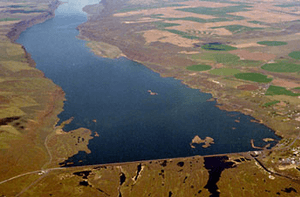Dry Falls Dam facts for kids
Quick facts for kids Dry Falls Dam |
|
|---|---|
 |
|
| Location | Grant County, Washington, USA |
| Coordinates | 47°37′12″N 119°18′27″W / 47.62000°N 119.30750°W |
| Opening date | 1949 |
| Operator(s) | United States Bureau of Reclamation |
| Dam and spillways | |
| Impounds | Grand Coulee |
| Height | 123 feet (37 m) |
| Length | 9,800 feet (2,990 m) |
| Width (base) | 480 feet (150 m) |
| Reservoir | |
| Creates | Banks Lake |
| Total capacity | 1,275,000 acre-feet (1.573 km3) |
| Catchment area | 278.3 square miles (721 km2) |
| Surface area | 27,000 acres (109 km2) |
The Dry Falls Dam is a special kind of dam built in the state of Washington, USA. It's located in Grant County, near a town called Coulee City. This dam is a key part of a huge project called the Columbia Basin Project. This project helps bring water to farms and communities.
The dam helps create a large lake called Banks Lake. Water from the Columbia River is pumped into a dry canyon called Grand Coulee. The Dry Falls Dam, along with another dam called North Dam, holds this water in place. From Banks Lake, water flows into canals to help irrigate farmland.
How the Dam Works
Dry Falls Dam is an earthfill dam. This means it's made mostly of earth and rock. It works with North Dam to form Banks Lake. This lake is about 27 miles (43 km) long.
Banks Lake holds a lot of water, about 715,000 acre-feet. This water is used for irrigation. It also helps create extra electricity when water flows back to the Columbia River. A large canal, called the Main Canal, starts near Dry Falls Dam. This canal carries water south to another lake, Billy Clapp Lake.
Building the Dam
The Dry Falls Dam was first called the South Coulee Dam. Construction started in 1946. Two companies, Roy L. Blair and Company and James Crick and Sons, won the contract to build it. The cost was about $2.7 million.
Workers first dug a deep trench along where the dam would be. They built a strong concrete wall in this trench. This wall stops water from leaking under the dam. It was about 3 feet (0.91 m) deep and 5 to 10 feet (1.5 to 3.0 m) high.
The dam itself was built in layers. It has a strong, waterproof core in the middle. On each side of the core are layers of earth that let some water through. The outside layers are made of rock. This design makes the dam very stable and strong. The main parts of the dam were finished by 1949.

